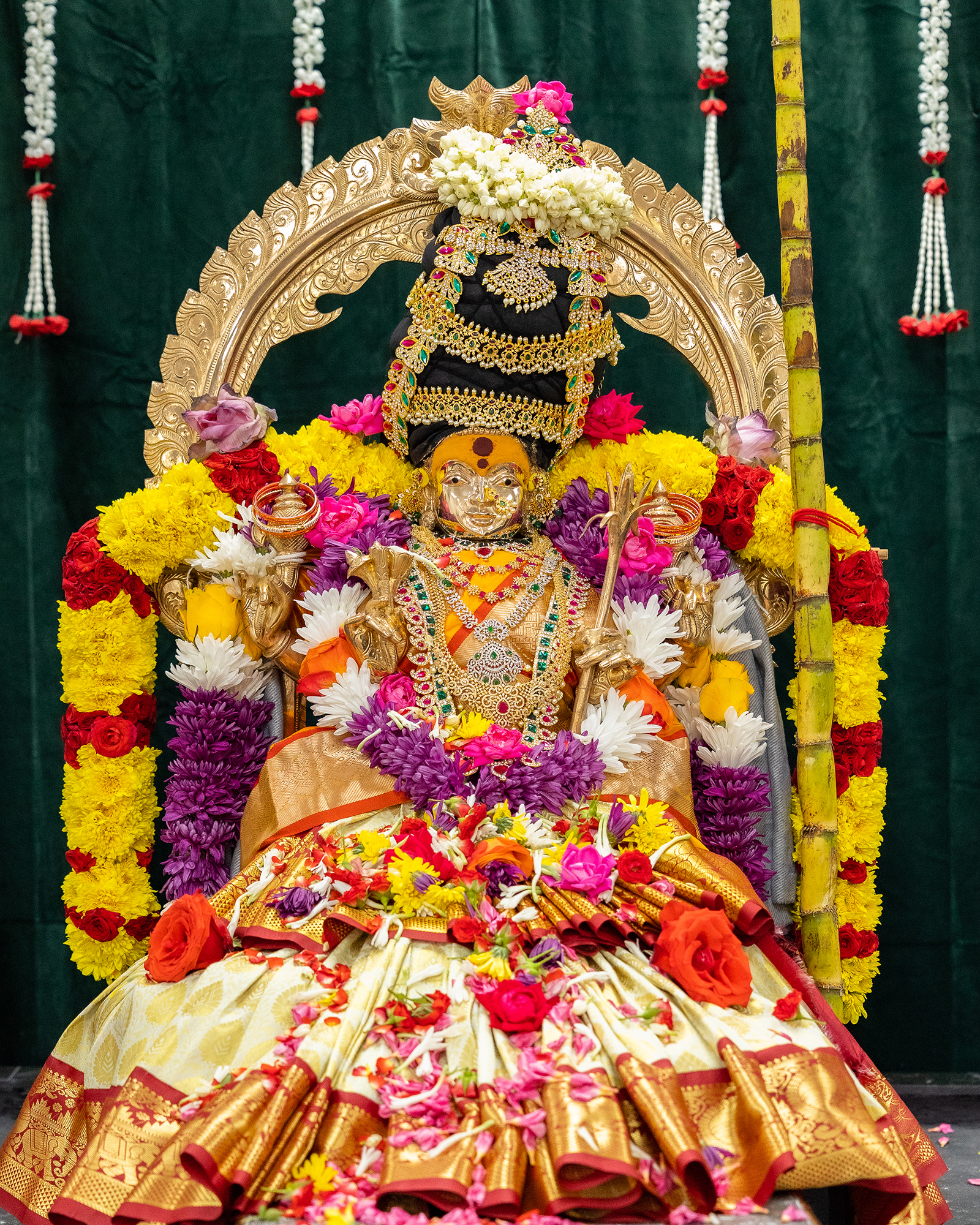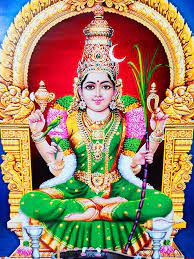
Lalitha Devi

Birthday
Marghashira Purnima
Origin Details
Lalitha Devi came out of the Chidagni Homa Kunda, which means the Divine mother manifested from the fire-pit of the Supreme Knowledge, to kill a demon by name Bhandasura who invaded and occupied the Heaven along with his army and started to hurt and pester the celestials. Therefore, we find the description as “Chidagnikunda sambhoota” “Deva kaarya samudyataa” in Lalitha Sahasranamam.
Sati Deha Tyaga (Self-immolation of Sati)
In the distant past, Sati Devi, a daughter of Daksha was married to Shiva. However gradually, Daksha developed hatred towards Shiva. Daksha intended to perform a Yajna (fire sacrifice) to which all the deities except Sati and Shiva, were invited. She went to the Yajna, despite of Shiva’s disapproval.
Daksha was furious by her uninvited arrival and insulted her and Shiva. Unable to bear the insult to Shiva, Sati Devi burnt her body in the fire.
Sati Devi was born as the daughter of Himavanta and Menaka. The newborn was named Parvati (daughter of Parvata-mountain). One day, the sage Narada visited Himavanta and said, Shiva is doing penance in your mountain range in his “Sthanu Ashrama” (abode of stones). After the departure of Sati Devi, He has become an ascetic. It will benefit you considerably if you send your daughter to serve Him”. He approached Shiva and prayed to him to allow Parvati to serve him.
Kama Dahana (Burning of Cupid)
This being so, a demon by name Bhandasura invaded and occupied the Heaven along with his army and started to hurt and pester the celestials. All of them approached Brahma for relief, who said, “The son born to Shiva and Parvati only can kill the demon. Due to this, the gods sought the help of Kamadeva, the god of love to unite Shiva and Parvati. He saw Parvati at Lord Shiva’s feet. He immediately aimed an arrow at them which struck Lord Shiva. Angered by this, Shiva turned Kama into ashes with his third eye.
Birth of Bhandasura
At this point of time, Chitrakarma, the commander of one of the Rudra Ganas one day started toying with the ash of the burnt Manmatha and prepared a doll out of it. He took this doll to Lord Shiva. As soon as the doll neared Lord Shiva, it sprang to life. Chitrakarma gave the boy the Upadesha of Shata-Rudreeya Mantra and asked him to undertake penance.
When the penance reached the stage of fruition, Lord Shiva appeared before him. He asked Lord Shiva to grant him a special boon “anyone who fights against me should immediately lose half of his strength and that strength should be added to my strength. None of the weapons of my opponents should be able to bind me”. Immediately Lord Shiva granted the boon and added, “I am also bestowing on you the boon of ruling the kingdom for sixty thousand years”.
Lord Brahma, who was witnessing all this, grew frustrated and swore “Bhand” “Bhand”. From then on, he got the name “Bhanda”. Because of his qualities he became an Asura (demon) and entered the domain of Asuras. This is how he got the name ‘Bhandasura’.
From the remnants of the ash of Manmatha were born two demons – Vishukra and Vishanga. These two became the main brothers of Bhandasura. He also created a new city named ‘Shoonyaka Pattanam’.
In addition, thousands of Rakshasas (demons) were born out of the ash of Manmatha. They formed a strong army of 300 Akshouhinis (one Akshouhini consists of 21870 elephants, 65610 horses and 109350 soldiers).
Fearing him and his vicious boons, the gods of the multiverse approached Sri Hari. Sri Hari said, there is however one Almighty God who is beyond this manifest Brahmanda. He is called Maha Shambhu.
Parashakti is constantly in his company. He can rescue us from our difficulties. Therefore, let us all take refuge in him and praise him. So saying, Sri Hari led all the gods to the brim of the Brahmanda (Universe). There was a huge wall like fence there. The angels summoned the celestial elephants to break the wall. After toiling continuously for one year, a breach was formed in the wall.
The Extraordinary Guru of Adi Shankara

After passing through the breach, they saw Chinmaya Akasha, which was Niralamba (independent), Nirajnana (untainted) and which was devoid of the five elements.They all stood in that Chinmaya Akasha and sang the glory of Maha Shambhu, who was of the form of Chidakasha.
Then Maha Shambhu appeared before them. He was dark like clouds. He had two hands. He was holding a Shoola (spear) in one hand and a Kapala (skull) in the other. He had three eyes.
Parashakti also appeared before them. She was holding Aksha Mala (rosary of beads) and Pustaka (book) in Her hands. She was bright and cool like the moon.
Maha Shambhu was aware of why they have come to him. They prayed to Maha Shambhu to teach them the method of appeasing Parashakti. Maha Shambhu explained:
- This is called as Maha Yaga. (Great fire sacrifice).
- I am (assuming the form of Vayu) the Hota (the priest who makes the offerings in a Homa) in this Yajna (fire sacrifice).
- My Chidagni itself is the fire in this Yajna.
- The last of the seven seas, i.e., Jala Samudra (Water Sea) has now dried up. The huge pit so formed itself is the Homa Kunda (fire pit where Homa is performed)
- The remaining six great oceans constitute the six drops of ghee which is used as offering.
- Srishti (creation) is of five types (i) Manasa Srishti (ii) Jarayavee Srishti (creation-taking place through the womb. E.g., Human beings), (iii) Anda Srishti (creation taking place through eggs) (iv) Swedaja Srishti (creation taking place through sweat) and (v)Udbhijja Srishti (creation taking place by sprouting). These five Srishtis (creations) are the sacrifice animals in this Maha Yaga.
- Bhoomi (land), Parvata (mountains), Jala (water), Vayu (air) and Akasha (space) these five are the substances used in this fire sacrifice. Agni element (one of the five elements) being a part of my Chidagni cannot be a substance to be offered.
- At the end of this great fire sacrifice, all of you (the performers of the Yajna) should jump in to the Homa Kunda (fire pit). While doing so, you must possess absolute devotion.
- Then, Lalita Parameshwari will manifest
After some time, Maha Shambhunatha, accompanied by Parashakti started chanting the Lalita Maha Mantra and entered the Universe in the form of the seven layered Vayu (air). Parashakti assumed the form of his Kriya Shakti (energy of action). With the help of Kriya Shakti, Vayu blew the Jala Samudra with all his energy. The Jala Samudra (water ocean) became totally dry.
In the pit thus formed the Chidagni with the help of fire emanating from the third eye. This Agni raged from the Patala (a region in the nether-world) to the Brahm Loka. After this, he performed the Yajna as ordained by the Vedas.
As the Homa progressed, the Chidagni emanating from it spread to vast area. He then offered the first six oceans and then the five-fold creations to this Agni. In the end, the gods jumped and offered themselves to Agni.
At the end of the Homa, Lalita Devi came out of the Chidagni Homa Kunda, seated on a special chariot called “Chakra Raja Ratha”.
Devata Significance
Goddess Lalitha represents the Panchabhuta (five basic elements) of the Universe. She is the combination of eternal grace, knowledge and determination. Sree Lalitha Sahasranamam, is most pleasing to Sree Lalitha Parameshvari. There is nothing to qual this in the Vedas or Tantras. The daily chanting of this hymn gives the same merit as that obtained from bathing in holy rivers and giving gifts of wealth, food, land and cows.
Special days for pooja
- Chaitra Navaratri
- Ashtami
- Pournami
Key benefits of worshipping
- Help attain good health, happiness and self-realization.
- Gain inner and material wealth and well-being.
- Help achieve harmony and balance at home and work.
- Gain relief from stress, grief, or any mental problems.
- Attain Moksha (Salvation).
Key Slokas
Lalitha Sahasranamam – Lalitha Sahasranamam is a sacred text which has been composed by eight Vak Devis upon the command of Goddess Lalitha. This hymn takes the thousand names in praise of Goddess Lalitha with great reverence. This stotram occupies an important place in the prayers offered to the Goddess.
Lalitha Trishati – Lalitha Trishati is the secret stotram of Lalitha Mahatripurasundari. Tri means three and shati means hundred, that is secret 300 names of Mother Lalitha.
Soundarya Lahari – Soundarya Lahari meaning “The waves of Beauty”. Its hundred slokas (verses) praises the beauty, grace and munificence of Goddess Tripura Sundari.